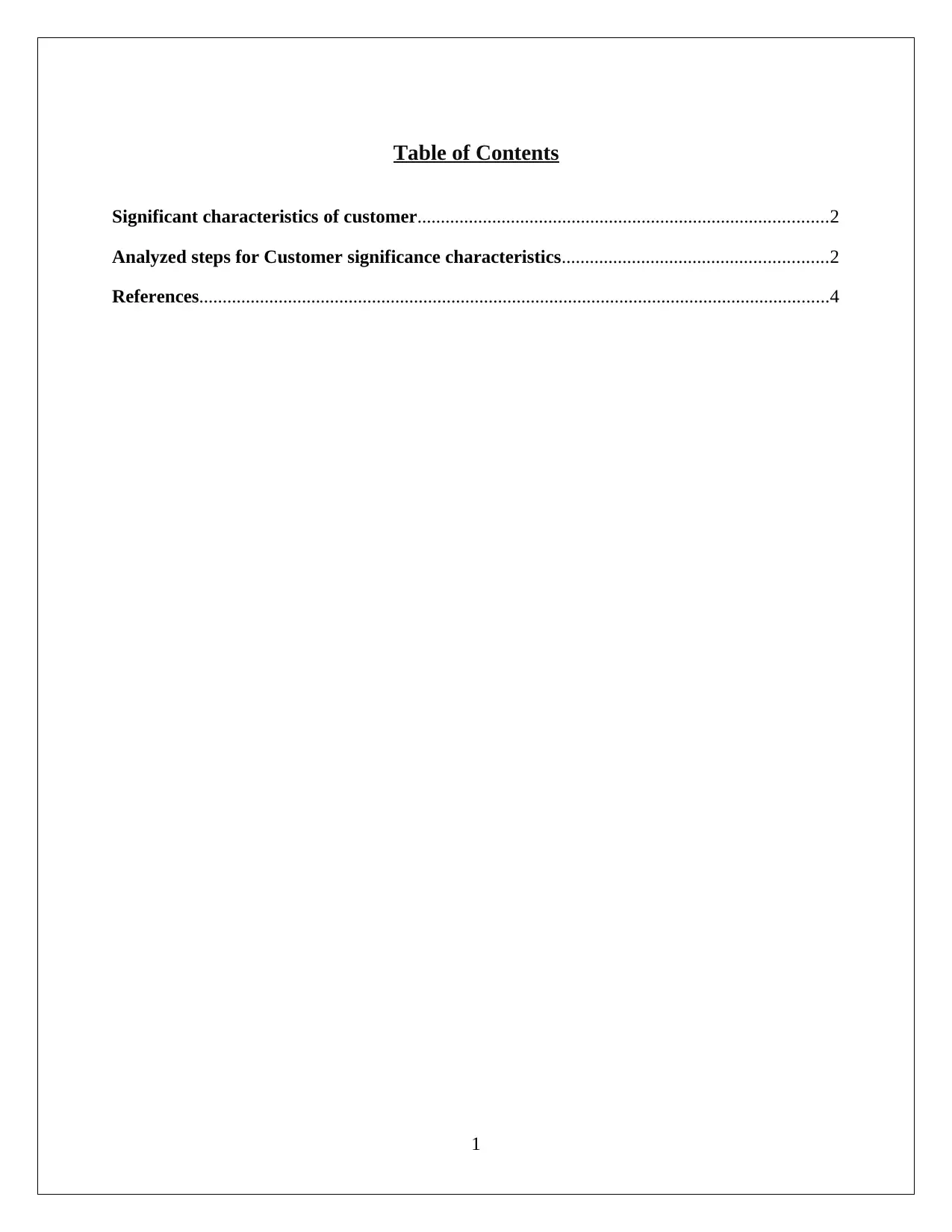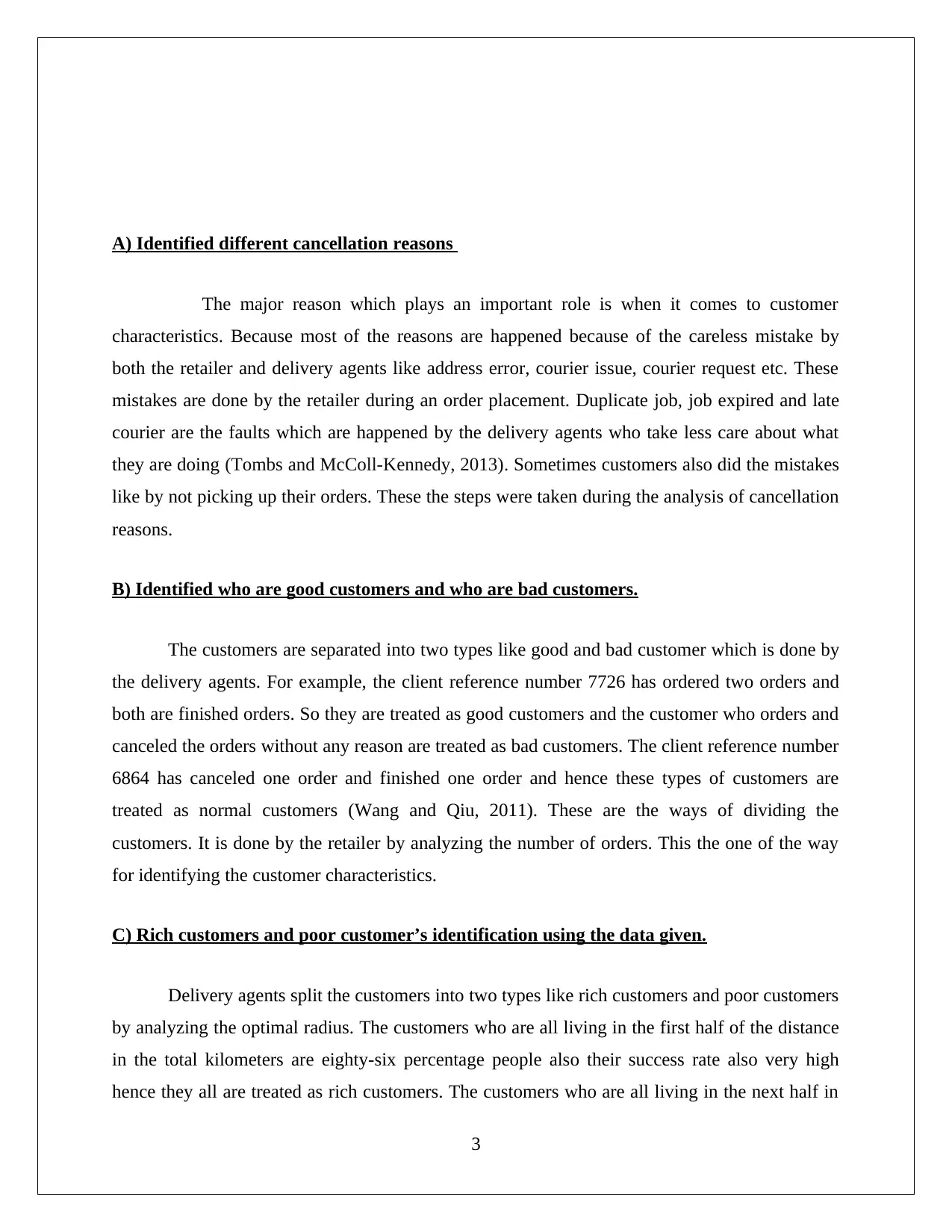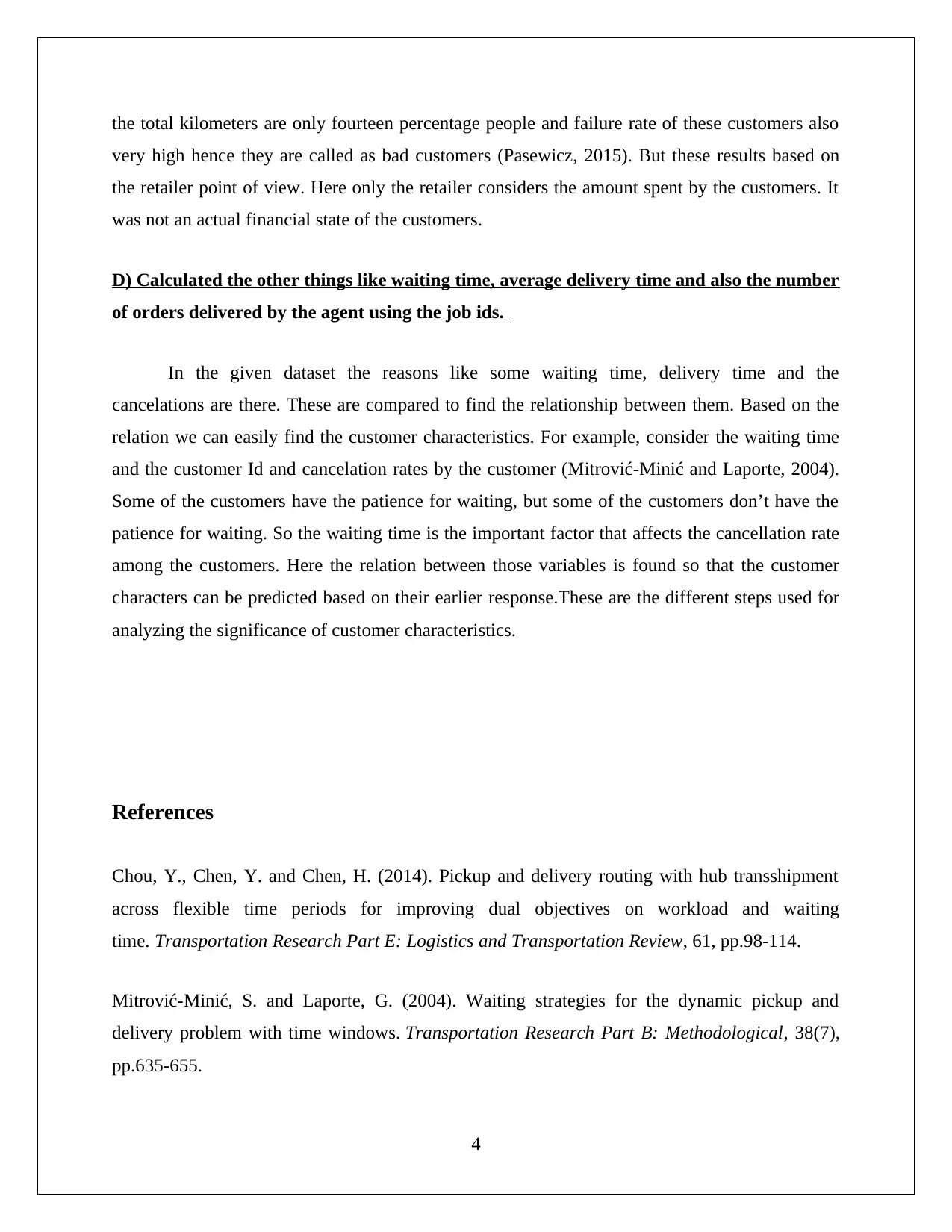Analyzing Customer Characteristics: Retail Order Data Analysis
VerifiedAdded on 2023/06/10
|6
|1184
|161
Report
AI Summary
This report analyzes customer characteristics using a dataset of 14,363 retail orders, focusing on the significance of customer behavior and its impact on order fulfillment. It identifies key factors influencing customer characteristics, such as retailer behavior and order cancellations. The analysis categorizes orders into finished and canceled, revealing that canceled orders often stem from issues like address errors, delivery agent mistakes, and customer actions like order cancellations. The report details the methodologies used, including R histogram and QGIS, to analyze cancellation reasons, identify good versus bad customers based on order history, and differentiate rich from poor customers based on delivery radius and success rates. Furthermore, it explores the correlation between waiting time, delivery time, and cancellation rates to predict customer behavior. The report concludes by emphasizing the importance of understanding customer characteristics to improve order fulfillment and enhance customer satisfaction, supported by relevant references.

DISSERTATION
Paraphrase This Document
Need a fresh take? Get an instant paraphrase of this document with our AI Paraphraser

Table of Contents
Significant characteristics of customer........................................................................................2
Analyzed steps for Customer significance characteristics.........................................................2
References.......................................................................................................................................4
1
Significant characteristics of customer........................................................................................2
Analyzed steps for Customer significance characteristics.........................................................2
References.......................................................................................................................................4
1

Significant characteristics of customer
In the given dataset, there are 14363 details about the orders. Among them, 1594 orders
are canceled and remaining 12769 orders are successfully finished. The finished orders always
give positive feedback from the customer and canceled order gives the bad review about the
retailer. The customer characteristics always depend on retailer’s behavior and the way they are
treating them. From the analysis of data there are different ways that relate with the customer
characteristics (Motowidlo, Brownlee and Schmit, 2008). For example, customer orders an order
but not given by the retailer due to too much of other orders. Then, another example is retailer
cancels the order by analyzing the previous cancellations of the particular customer, these
cancellations are done with the help of already stored data of customers and these are all the
different reasons for non-delivery of orders which are related to customer characteristics (Chou,
Chen and Chen, 2014).
Even though there are many reasons the main reasons for cancelling of orders are based
on the following reasons. These cancellations are done by the delivery agents or the customers.
The reasons are addressed error, duplicate job, package damaged, pick up closed, wrong
transport type used etc. these are already represented using different histogram for the respected
reasons.
Analyzed steps for Customer significance characteristics
The significance characteristics of customer was analyzed using the given data and also
various methodologies are used to analyze the given data. The methodologies are R histogram,
QGIS etc. these are used to identify the customer characteristics in the form of graphical
representation. Using these not only characteristics and also other things are easily identified.
Even though the given data set has larger details, the analysis are easy during the histogram
generation. The significance characteristics of customers are identified using different steps.
They are:
2
In the given dataset, there are 14363 details about the orders. Among them, 1594 orders
are canceled and remaining 12769 orders are successfully finished. The finished orders always
give positive feedback from the customer and canceled order gives the bad review about the
retailer. The customer characteristics always depend on retailer’s behavior and the way they are
treating them. From the analysis of data there are different ways that relate with the customer
characteristics (Motowidlo, Brownlee and Schmit, 2008). For example, customer orders an order
but not given by the retailer due to too much of other orders. Then, another example is retailer
cancels the order by analyzing the previous cancellations of the particular customer, these
cancellations are done with the help of already stored data of customers and these are all the
different reasons for non-delivery of orders which are related to customer characteristics (Chou,
Chen and Chen, 2014).
Even though there are many reasons the main reasons for cancelling of orders are based
on the following reasons. These cancellations are done by the delivery agents or the customers.
The reasons are addressed error, duplicate job, package damaged, pick up closed, wrong
transport type used etc. these are already represented using different histogram for the respected
reasons.
Analyzed steps for Customer significance characteristics
The significance characteristics of customer was analyzed using the given data and also
various methodologies are used to analyze the given data. The methodologies are R histogram,
QGIS etc. these are used to identify the customer characteristics in the form of graphical
representation. Using these not only characteristics and also other things are easily identified.
Even though the given data set has larger details, the analysis are easy during the histogram
generation. The significance characteristics of customers are identified using different steps.
They are:
2
⊘ This is a preview!⊘
Do you want full access?
Subscribe today to unlock all pages.

Trusted by 1+ million students worldwide

A) Identified different cancellation reasons
The major reason which plays an important role is when it comes to customer
characteristics. Because most of the reasons are happened because of the careless mistake by
both the retailer and delivery agents like address error, courier issue, courier request etc. These
mistakes are done by the retailer during an order placement. Duplicate job, job expired and late
courier are the faults which are happened by the delivery agents who take less care about what
they are doing (Tombs and McColl-Kennedy, 2013). Sometimes customers also did the mistakes
like by not picking up their orders. These the steps were taken during the analysis of cancellation
reasons.
B) Identified who are good customers and who are bad customers.
The customers are separated into two types like good and bad customer which is done by
the delivery agents. For example, the client reference number 7726 has ordered two orders and
both are finished orders. So they are treated as good customers and the customer who orders and
canceled the orders without any reason are treated as bad customers. The client reference number
6864 has canceled one order and finished one order and hence these types of customers are
treated as normal customers (Wang and Qiu, 2011). These are the ways of dividing the
customers. It is done by the retailer by analyzing the number of orders. This the one of the way
for identifying the customer characteristics.
C) Rich customers and poor customer’s identification using the data given.
Delivery agents split the customers into two types like rich customers and poor customers
by analyzing the optimal radius. The customers who are all living in the first half of the distance
in the total kilometers are eighty-six percentage people also their success rate also very high
hence they all are treated as rich customers. The customers who are all living in the next half in
3
The major reason which plays an important role is when it comes to customer
characteristics. Because most of the reasons are happened because of the careless mistake by
both the retailer and delivery agents like address error, courier issue, courier request etc. These
mistakes are done by the retailer during an order placement. Duplicate job, job expired and late
courier are the faults which are happened by the delivery agents who take less care about what
they are doing (Tombs and McColl-Kennedy, 2013). Sometimes customers also did the mistakes
like by not picking up their orders. These the steps were taken during the analysis of cancellation
reasons.
B) Identified who are good customers and who are bad customers.
The customers are separated into two types like good and bad customer which is done by
the delivery agents. For example, the client reference number 7726 has ordered two orders and
both are finished orders. So they are treated as good customers and the customer who orders and
canceled the orders without any reason are treated as bad customers. The client reference number
6864 has canceled one order and finished one order and hence these types of customers are
treated as normal customers (Wang and Qiu, 2011). These are the ways of dividing the
customers. It is done by the retailer by analyzing the number of orders. This the one of the way
for identifying the customer characteristics.
C) Rich customers and poor customer’s identification using the data given.
Delivery agents split the customers into two types like rich customers and poor customers
by analyzing the optimal radius. The customers who are all living in the first half of the distance
in the total kilometers are eighty-six percentage people also their success rate also very high
hence they all are treated as rich customers. The customers who are all living in the next half in
3
Paraphrase This Document
Need a fresh take? Get an instant paraphrase of this document with our AI Paraphraser

the total kilometers are only fourteen percentage people and failure rate of these customers also
very high hence they are called as bad customers (Pasewicz, 2015). But these results based on
the retailer point of view. Here only the retailer considers the amount spent by the customers. It
was not an actual financial state of the customers.
D) Calculated the other things like waiting time, average delivery time and also the number
of orders delivered by the agent using the job ids.
In the given dataset the reasons like some waiting time, delivery time and the
cancelations are there. These are compared to find the relationship between them. Based on the
relation we can easily find the customer characteristics. For example, consider the waiting time
and the customer Id and cancelation rates by the customer (Mitrović-Minić and Laporte, 2004).
Some of the customers have the patience for waiting, but some of the customers don’t have the
patience for waiting. So the waiting time is the important factor that affects the cancellation rate
among the customers. Here the relation between those variables is found so that the customer
characters can be predicted based on their earlier response.These are the different steps used for
analyzing the significance of customer characteristics.
References
Chou, Y., Chen, Y. and Chen, H. (2014). Pickup and delivery routing with hub transshipment
across flexible time periods for improving dual objectives on workload and waiting
time. Transportation Research Part E: Logistics and Transportation Review, 61, pp.98-114.
Mitrović-Minić, S. and Laporte, G. (2004). Waiting strategies for the dynamic pickup and
delivery problem with time windows. Transportation Research Part B: Methodological, 38(7),
pp.635-655.
4
very high hence they are called as bad customers (Pasewicz, 2015). But these results based on
the retailer point of view. Here only the retailer considers the amount spent by the customers. It
was not an actual financial state of the customers.
D) Calculated the other things like waiting time, average delivery time and also the number
of orders delivered by the agent using the job ids.
In the given dataset the reasons like some waiting time, delivery time and the
cancelations are there. These are compared to find the relationship between them. Based on the
relation we can easily find the customer characteristics. For example, consider the waiting time
and the customer Id and cancelation rates by the customer (Mitrović-Minić and Laporte, 2004).
Some of the customers have the patience for waiting, but some of the customers don’t have the
patience for waiting. So the waiting time is the important factor that affects the cancellation rate
among the customers. Here the relation between those variables is found so that the customer
characters can be predicted based on their earlier response.These are the different steps used for
analyzing the significance of customer characteristics.
References
Chou, Y., Chen, Y. and Chen, H. (2014). Pickup and delivery routing with hub transshipment
across flexible time periods for improving dual objectives on workload and waiting
time. Transportation Research Part E: Logistics and Transportation Review, 61, pp.98-114.
Mitrović-Minić, S. and Laporte, G. (2004). Waiting strategies for the dynamic pickup and
delivery problem with time windows. Transportation Research Part B: Methodological, 38(7),
pp.635-655.
4

Motowidlo, S., Brownlee, A. and Schmit, M. (2008). Effects of Personality Characteristics on
Knowledge, Skill, and Performance in Servicing Retail Customers. International Journal of
Selection and Assessment, 16(3), pp.272-280.
Pasewicz, W. (2015). TOTAL PROBABILITY OF THE WRONG DECISION IN
TRANSPORT JUNCTION. Russian Journal of Logistics and Transport Management, 2(1),
pp.20-25.
Tombs, A. and McColl-Kennedy, J. (2013). Third Party Customers Infecting Other Customers
for Better or for Worse. Psychology & Marketing, 30(3), pp.277-292.
Wang, C. and Qiu, Y. (2011). Vehicle Routing Problem with Stochastic Demands and
Simultaneous Delivery and Pickup. Applied Mechanics and Materials, 148-149, pp.810-813.
5
Knowledge, Skill, and Performance in Servicing Retail Customers. International Journal of
Selection and Assessment, 16(3), pp.272-280.
Pasewicz, W. (2015). TOTAL PROBABILITY OF THE WRONG DECISION IN
TRANSPORT JUNCTION. Russian Journal of Logistics and Transport Management, 2(1),
pp.20-25.
Tombs, A. and McColl-Kennedy, J. (2013). Third Party Customers Infecting Other Customers
for Better or for Worse. Psychology & Marketing, 30(3), pp.277-292.
Wang, C. and Qiu, Y. (2011). Vehicle Routing Problem with Stochastic Demands and
Simultaneous Delivery and Pickup. Applied Mechanics and Materials, 148-149, pp.810-813.
5
⊘ This is a preview!⊘
Do you want full access?
Subscribe today to unlock all pages.

Trusted by 1+ million students worldwide
1 out of 6
Your All-in-One AI-Powered Toolkit for Academic Success.
+13062052269
info@desklib.com
Available 24*7 on WhatsApp / Email
![[object Object]](/_next/static/media/star-bottom.7253800d.svg)
Unlock your academic potential
Copyright © 2020–2025 A2Z Services. All Rights Reserved. Developed and managed by ZUCOL.
